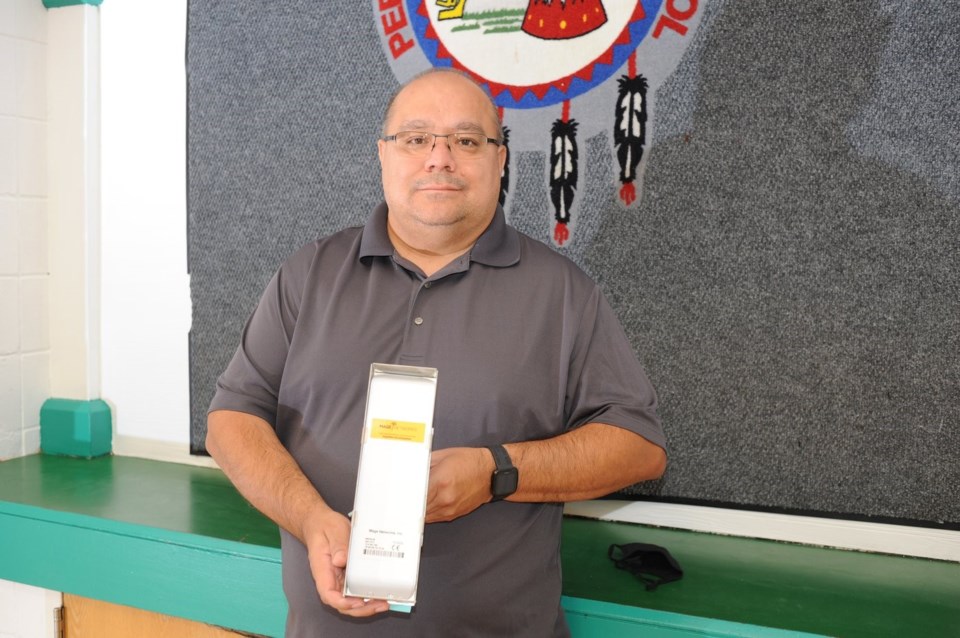PEEPEEKISIS CREE NATION — One node at a time, the Peepeekisis Cree Nation is getting all of its students online.
Thanks to a newly installed, self-contained signal relay network, the First Nation can now beam Internet signals into all of its students’ homes in the 38-square-kilometre reserve.
“This technology allows us to broadcast that beam a few kilometres away and pick it up with another node and then repeat it and keep amplifying the signal down the road,” Peepeekisis operations director Ernest Standingready said.
It’s the solution he, principal David Still and education director Joy Sapp chose to address physical distancing requirements brought by the COVID-19 pandemic.
Thus far the technology is working: Kindergarten to Grade 9 students at the community’s Pesakastew School are now learning from home via their computers, after starting school this week. The band had already gone through a trial run with Grade 12 students using the signal-boosting node network last school year, when students were sent home in mid-March.
Calgary-based software and hardware company Mage Networks is providing Peepeekisis the parts for the network.
On its website, Mage says its modular nodes, slightly bigger than a 1980s-era brick cellphone, can send signals from behind and around obstacles and through foliage. Touting its technology’s ability to maintain data transfer consistency, the company says its modular networks are made to handle inconsistent, rural terrain.
"When the schools closed, a lot of the options were being explored” for back-to-school options, Standingready said.
“It makes it that much more difficult when we're on a First Nation that doesn't have the basic infrastructure for the Internet, or even reliable, fast internet: A lot of houses are a few kilometres away (from each other); they're not even tied into public infrastructure … Trying to find a way to get a signal out there was the biggest hurdle, but we were on that early.”
As it’s now set up, Pesakastew School sends its SaskTel-provided Internet signal through the Mage Networks nodes, which are spaced out every few kilometres throughout the community.
Standingready said some of Peepeekisis’ homes have the white, plastic nodal single-relayers attached to them.
He, Still and Sapp control the network by only allowing registered devices onto it and restricting what websites can be accessed.
Prior to the set-up, only 30 per cent of families registered through the school had any Internet access, Still said.
Seventy per cent had to previously rely on cellphone data to access the web or do any sort of online communication, a non-starter for a teaching set-up that requires consistent uninterrupted access to online tools, he said.
Last year approximately 130 students registered in the school.
Still said he doesn’t have this year’s enrolment number, because he’s expecting some Peepeekisis families to transfer their kids from nearby Balcarres Community School back to Pesakastew to use the online option.
As of Thursday, “the elementary kids (kindergarten to Grade 9) for the month of September are still running digitally,” he said.
Ensuring the nodal network works "is going to be our big test for this new connectivity project,” Still said.
The school has given each registered household a computer so kids don’t have any barriers accessing their education.
To account for homes with siblings in different grades but only one computer, Sapp helped organize blocked-off times throughout the day for each grade to plug in for hour-long lessons.
She confirmed Peepeekisis is paying for the program after accessing federal funding under the Indigenous Community Support Fund.
The community, with 643 registered members living on reserve, has not recorded a COVID-19 infection.
Pesakastew School has also instituted other COVID-19-related measures, like touchless bathroom appliances, specific entry and exit doors, body temperature checks, attendance at school for half-days, class cohorting of 12 students or fewer and PPE usage, Sapp said.




